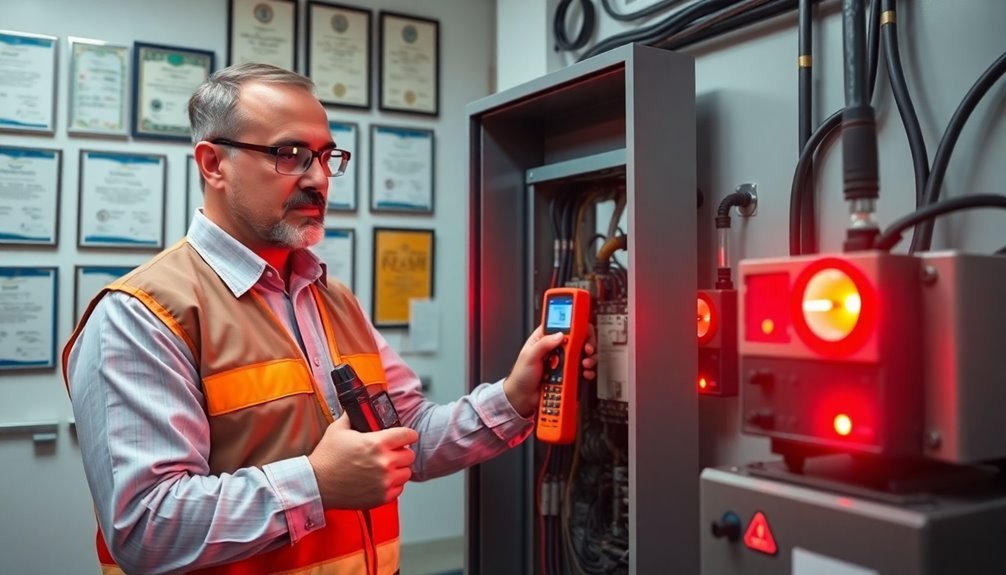Professional certification for electronic safety trainers isn't just a credential – it's a vital investment in workplace safety and your career growth. You'll gain thorough knowledge of OSHA standards, NFPA 70E requirements, and ANSI Z490.1 guidelines, helping you prevent workplace accidents and comply with legal requirements. With certification, you can reduce organizational risks, lower insurance premiums, and advance your career prospects, potentially earning up to $115,590 annually. You'll master essential skills in hazard identification, risk management, and effective training delivery. The deeper you explore certification's benefits, the more value you'll discover for both you and your organization.
Industry Standards and Credibility

While electronic safety training has evolved substantially, industry standards remain the cornerstone of trainer certification and credibility. You'll find that key guidelines like ANSI Z490.1-2016 and OSHA standards 1910.120(e)(5) establish vital criteria for acceptable safety training practices. These standards don't just suggest best practices – they're essential benchmarks you must meet to maintain professional standing.
As a safety trainer, you're expected to demonstrate both thorough knowledge and practical experience in your field. You'll need to stay current with industry-specific challenges and regulations, as national consensus standards like ANSI Z359.0-2018 emphasize this dual requirement. Qualified trainers must have satisfactorily completed specialized courses for teaching their subjects or possess the necessary academic credentials.
Your commitment to continuing education isn't optional – it's fundamental to maintaining your training effectiveness.
Your credibility directly impacts training outcomes. When you develop clear, concise programs, you're not just fulfilling requirements; you're actively preventing unnecessary expenses and ensuring student mastery of critical safety skills.
Through continuous auditing and monitoring, you'll verify that your training programs meet health and safety regulations while providing valuable feedback to management and contractors.
Legal Compliance Requirements
Building on industry standards, legal compliance forms the bedrock of electronic safety trainer certification. You'll need to understand and adhere to OSHA's electrical safe work practices and NFPA 70E requirements to effectively train others in electrical safety protocols.
Supervisory oversight ensures proper employee compliance with established safety protocols. As a certified trainer, you're required to guarantee compliance with OSHA's Safeguards for Employee Protection while implementing NFPA 70E Article 110.1.A's electrical safety program requirements.
You'll be responsible for teaching proper lockout/tagout procedures and conducting arc flash assessments that must be updated every five years.
Your certification must demonstrate your ability to meet NFPA 70E Article 110.2.D.3's mandate for retraining workers every three years.
You'll also need to maintain detailed documentation of all training sessions and verify that your credentials remain current and relevant to industry-specific challenges.
When pursuing certification, you must show proficiency in developing thorough training programs that address current risks and legal standards.
Your certification validates your capability to communicate clear safety protocols and guarantee proper implementation of electrical protective equipment requirements, making you legally qualified to conduct safety training sessions.
Risk Management Benefits

Every certified electronic safety trainer brings substantial risk management benefits to their organization. You'll find that these professionals play a vital role in preventing financial losses by implementing effective risk management strategies and ensuring employees avoid costly mistakes.
They'll help your organization allocate resources more efficiently while maintaining financial stability through proper risk assessment and mitigation.
When you invest in certified trainers, you're enhancing your organization's decision-making capabilities. They'll help your leaders understand various risk factors and their potential impacts, leading to more informed choices about new markets or products. You're also gaining experts who can spot risks early and develop appropriate countermeasures. These professionals ensure your organization maintains compliance with regulations, helping you avoid legal issues and penalties.
You'll notice improved efficiency and productivity as these certified trainers establish clear, straightforward processes. They'll help your workers complete projects safely while maintaining focus, reducing anxiety about potential hazards.
Additionally, they're instrumental in developing a robust safety culture, ensuring all emergency equipment is functional and safety standards are consistently monitored.
Professional Development Opportunities
As an electrical safety trainer, you'll find numerous pathways to advance your expertise through specialized certifications, OSHA authorizations, and thorough training programs.
You can boost your career trajectory by joining professional communities like ASSP's Training and Communications Practice Specialty, which provides access to valuable resources and networking opportunities. Safe work practices are a critical component of the training curriculum, ensuring you can effectively teach proper safety protocols and corrective measures.
Your professional growth potential expands through leadership roles, continuous learning platforms, and industry recognition that comes with maintaining current certifications and staying updated on safety management trends.
Advanced Learning Pathways
Developing your professional expertise in electronic safety requires a structured approach to continuous learning. You'll need to engage with thorough training frameworks that combine microlearning modules, compliance training, and expert-developed video content to build your foundational knowledge.
Your learning journey should follow strategic curriculum pathways that progress through awareness, application, and knowledge expansion stages. These stages are designed with multi-modal formats to enhance skill mastery and drive behavior change. You'll find that well-curated programs reduce the need for extensive content searches while guaranteeing you're meeting specific L&D goals and risk reduction requirements.
Key areas you'll need to master include cybersecurity, AI collaboration, and business ethics.
To advance your expertise, you'll want to take advantage of professional development opportunities through established platforms. CDC TRAIN offers over 1,000 relevant courses, while programs like NSC's Advanced Safety Certificate provide in-depth training on safety leadership skills.
You'll need to guarantee your certifications are ANSI Z490.2 compliant and offer CEUs for continuing education requirements. Remember that interactive elements and industry-specific content are vital for maximum learning retention.
As safety standards evolve, you'll need to maintain your expertise through ongoing education and professional development programs.
Career Growth Horizons
Professional development in electronic safety training offers three distinct career advancement paths: specialized certification acquisition, leadership role progression, and industry expertise development.
By pursuing advanced certifications like HAZWOPER and Construction Safety, you'll expand your qualifications and increase your market value. Safety trainers who obtain certifications can earn up to $115,590 annually.
Your leadership journey can begin with OSHA teaching certifications and grow through continuous professional development. You'll need to maintain your certifications while building essential skills in communication, risk assessment, and regulatory compliance.
Joining professional organizations like ASSP will connect you with technical resources and industry peers, accelerating your growth potential.
To develop industry expertise, you'll want to focus on specialized programs like the Electrical Safety Trainer Course. These programs enhance your credibility and prepare you for higher-level positions.
As you gain experience, you can move into supervisory roles overseeing safety programs and teams. Remember to stay current with industry regulations through continuing education and certification renewals.
Your commitment to professional growth through DOT compliance, safety program management, and specialized training will open doors to advanced opportunities in electronic safety training leadership.
Training Delivery Best Practices

Successful electrical safety training hinges on effective delivery techniques that engage participants and guarantee knowledge retention. You'll need to create a safe, controlled environment that minimizes distractions and allows learners to focus on critical safety concepts.
Confirm that your training facility meets all safety standards and that you're using well-maintained equipment for demonstrations and hands-on exercises.
When delivering training, you'll want to combine multiple teaching methods to accommodate different learning styles. Incorporate classroom instruction with practical demonstrations, and use interactive multimedia resources to enhance engagement. Selecting a CESCP certified trainer helps ensure instruction meets industry standards and regulatory requirements.
You should sequence your topics logically, starting with foundational concepts before progressing to more complex procedures like LOTO and emergency response protocols.
Remember to adjust your delivery pace based on participant feedback and comprehension levels. You'll need to confirm understanding through frequent checks and encourage questions throughout the session.
Break complex topics into digestible segments and reinforce key points through hands-on practice. By maintaining a balance between theoretical knowledge and practical application, you'll help confirm that participants develop both the understanding and skills needed for electrical safety compliance.
Certification Program Selection
Once you've mastered training delivery techniques, selecting the right certification program becomes your next key step. To make the best choice, you'll need to evaluate programs based on several critical factors that guarantee both quality and compliance.
Start by verifying that your chosen program aligns with OSHA standards and NFPA 70E requirements, as these form the foundation of electrical safety training. Look for programs from established providers like e-Hazard or Martin Technical that offer thorough course content covering electrical hazards, safe operations, and emergency procedures. Most comprehensive programs require 120-150 minutes to complete the training materials effectively.
You'll want to guarantee the certification includes hands-on training components and real-world scenarios.
When comparing programs, prioritize those that provide train-the-trainer options and customizable materials. These features will help you adapt the content to your specific training needs while maintaining regulatory compliance.
Check if the program offers online learning options, which can provide flexibility and cost savings.
Don't forget to examine the certification process itself – you'll need to understand the exam requirements, training kit provisions, and available ongoing support.
The right program should enhance your professional credibility while equipping you with the tools to deliver effective, compliant training.
Safety Culture Enhancement

Building a strong safety culture requires more than just certification – it demands a thorough approach that integrates technology, training, and continuous engagement.
As an electronic safety trainer, you'll find that professional certifications like MSP and CSD equip you with the knowledge to identify hazards and implement effective mitigation strategies.
You'll be able to leverage technology-supported training platforms that allow employees to access safety education from anywhere. By incorporating AI tools, smart protective equipment, and IoT sensors, you can create a more responsive and predictive safety environment. These technologies help you monitor potential risks in real-time and intervene before incidents occur.
Your certification guarantees you're well-versed in regulatory requirements and can maintain proper documentation of safety activities. You'll understand how to establish and implement educational programs that comply with legal standards while fostering employee engagement.
Return on Investment
By becoming a certified electronic safety trainer, you'll potentially reduce insurance premiums through improved training outcomes and decreased workplace incidents.
Your certification opens doors to career advancement opportunities, including higher-paying positions and consulting roles in safety management.
The growing demand for qualified electronic safety trainers leads to increased training contract values, offering you the chance to earn more while delivering crucial safety education to organizations.
Reduced Insurance Premiums
Organizations that invest in electronic safety training programs can look forward to substantial reductions in their insurance premiums over time. Studies show that for every $1 you invest in safety programs, you'll save $4-$6 in insurance-related costs. When you prioritize thorough safety training through certified electronic trainers, you're actively reducing workplace incidents and subsequent claims.
| Insurance Benefit | Financial Impact |
|---|---|
| Lower Premiums | 4-6x return on investment |
| Reduced Claims | Fewer payouts and legal costs |
| Long-term Savings | Sustained premium reductions |
| Business Growth | Redirect savings to operations |
You'll find that maintaining a certified safety training program demonstrates to insurance providers your commitment to risk reduction. This commitment typically results in preferential premium rates and better coverage options. By implementing electronic safety training through certified professionals, you're creating a documented trail of your safety initiatives, which insurance companies view favorably when determining rates.
The key is consistency in your training approach. When you work with certified electronic safety trainers, you're ensuring that your safety program meets industry standards while maximizing your potential for insurance premium reductions.
Career Advancement Opportunities
The investment in electronic safety trainer certification yields substantial career advancement opportunities across multiple industries. You'll gain a competitive edge in the job market, as employers actively seek certified professionals due to their proven credibility and validated skills. This certification demonstrates your commitment to industry standards and enhances your marketability.
With certification, you'll position yourself for higher-paying roles and better benefits packages. Certified professionals often command premium salaries and have greater negotiating power when considering job offers.
Your certification signals to managers that you're ready for advancement, making you a prime candidate for supervisory positions and safety management roles.
Your certification can save employers over $10,000 annually through your enhanced skill set, making you a valuable asset to any organization. Government recognition of your certification opens doors to new responsibilities and geographical locations, expanding your career possibilities.
You'll also gain professional credibility as someone who can implement effective safety practices and promote a stronger safety culture. Companies value certified trainers for their reliability, expertise, and ability to maintain high safety standards, which translates into better career prospects and sustained professional growth.
Increased Training Contract Values
Investment-savvy safety trainers can secure higher contract values through documented return on investment metrics. When you're able to prove your training programs deliver significant cost savings and measurable ROI, you'll position yourself to command premium rates for your services.
Studies have shown that online safety training solutions can achieve ROI rates as high as 317%, making it a compelling selling point for potential clients.
You'll strengthen your case for higher contract values by highlighting how your electronic training methods reduce costs across multiple areas. You can demonstrate savings from decreased administrative time, minimized production disruptions, and the ability to schedule training during off-peak periods.
Additionally, you're able to show how your expertise in compliance and risk management helps clients avoid expensive accidents, lawsuits, and regulatory penalties.
Your certification equips you with data collection and analysis skills that prove your program's financial impact. By using statistical methods to isolate training effects and translate them into monetary values, you'll create compelling reports that justify increased contract rates.
Clients are willing to pay more when you can demonstrate how your safety training programs directly contribute to their bottom line through reduced risks and improved operational efficiency.
Workplace Accident Prevention

Numerous workplace accidents can be prevented through systematic safety measures and proper training protocols. As an electronic safety trainer, you'll need to understand that falls, vehicle crashes, and equipment-related incidents make up a significant portion of workplace accidents.
Your certification ensures you're qualified to teach others how to implement essential preventive measures.
When you're certified, you'll be equipped to deliver thorough training on:
- Personal protective equipment selection and proper usage
- Safe driving practices and vehicle operation procedures
- Fall protection systems and ladder safety protocols
You'll play a critical role in reducing workplace accidents by teaching proper ergonomics, emergency procedures, and equipment handling. Your expertise will help organizations establish effective safety policies that protect workers and reduce costly accidents.
Workplace injuries and deaths cost businesses billions annually, making your role as a certified trainer increasingly valuable.
Your certification demonstrates you understand both the human and financial implications of workplace safety. Through your training programs, you'll help companies create a robust safety culture that not only prevents accidents but also improves productivity and worker satisfaction.
Trainer Competency Assessment
You'll need to employ multiple methods to properly validate a safety trainer's skills, including both hands-on observations and documentation reviews.
Your technical knowledge verification should incorporate expert assessments and standardized testing to confirm trainers meet industry-specific requirements.
When measuring trainer performance, you must use consistent evaluation standards that combine practical demonstrations, theoretical understanding, and documented experience in electronic safety protocols.
Skills Validation Methods
The thorough assessment of trainer competencies requires a multi-faceted approach that combines observation, interviews, projects, and portfolio reviews. You'll find that practical evaluations in real-world scenarios provide the most reliable insights into your training capabilities, while structured interviews help validate your technical knowledge and problem-solving skills.
To effectively validate your skills as an electronic safety trainer, you'll need to demonstrate proficiency through:
- Hands-on demonstrations of safety protocols and training techniques in live environments
- Project-based assessments that showcase your ability to develop and deliver detailed safety training programs
- Portfolio submissions that document your past successes and certifications in electronic safety training
Your competency validation will include customized assessments specific to electronic safety protocols, with subject matter experts evaluating your performance through real-time observation. They'll review your previous experience, verify your certifications, and assess your ability to handle emergency scenarios.
You'll also participate in simulation-based projects that test your decision-making abilities under pressure. Remember, self-assessment plays a vital role in identifying areas where you need improvement, helping you maintain high standards in electronic safety training.
Technical Knowledge Verification
Professional safety trainers must undergo rigorous technical knowledge verification to verify they possess the required expertise and competencies. You'll need to demonstrate mastery across multiple domains, including core training principles, adult learning methodologies, and transfer of learning strategies. Your knowledge base must encompass both theoretical understanding and practical application of safety protocols.
To validate your technical expertise, you'll participate in thorough assessments that evaluate your curriculum development skills, assessment methods proficiency, and ability to design effective learning objectives. You'll need to show you can differentiate between training needs and performance issues while maintaining current knowledge of legal requirements and industry regulations.
The verification process includes both theoretical testing and practical demonstrations through real-world scenarios. You'll undergo expert reviews and receive multi-rater feedback to confirm you're meeting all competency standards.
As part of the assessment, you'll demonstrate your ability to collaborate with organizational leaders and promote learning transfer. This verification confirms you can effectively deliver safety training that improves workplace efficiency, reduces incidents, and cultivates a safety-conscious culture while maintaining ethical standards and copyright compliance.
Performance Measurement Standards
Building upon verified technical knowledge, a thorough competency assessment system measures and validates trainer performance through multiple evaluation methods.
You'll need to demonstrate your expertise through text-based assessments that evaluate your understanding of safety standards, hazard identification, and risk management protocols. These assessments include scenario-based questions that test your decision-making capabilities in critical situations.
Your performance will be evaluated through direct observation during actual training sessions, where you'll need to showcase:
- Effective communication of complex safety concepts
- Proper demonstration of safety equipment usage
- Appropriate handling of emergency scenarios and critical incidents
Regular performance reviews track your progress and effectiveness as a safety trainer. You're expected to maintain high standards through continuous professional development and stay current with emerging safety technologies.
Your certification requirements must align with recognized safety training organizations and industry-specific regulations, including familiarity with standards like EN ISO 13849-1. The assessment process guarantees you're not just knowledgeable but also capable of delivering practical, effective safety training that meets industry demands.
Continuing Education Pathways

Safety professionals seeking to maintain their electronic safety trainer certification must engage in continuous education to stay current with evolving industry standards and technologies. You'll need to pursue various learning pathways that combine online training, specialized courses, and hands-on experience to meet OSHA requirements and industry standards.
| Training Type | Delivery Method | Key Benefits |
|---|---|---|
| Online Programs | Web-based platforms | Flexible scheduling, self-paced learning |
| Specialized Courses | Hybrid or in-person | Industry-specific knowledge, direct feedback |
| Certification Programs | Trainer-led sessions | Professional credentials, structured advancement |
| General Industry Training | Self-study or classroom | Broad safety knowledge, regulatory compliance |
You'll find that continuing education isn't just about maintaining certification—it's essential for your professional growth and credibility. Through ESA National Training School and organizations like NASP, you can access thorough training programs that cover everything from HAZWOPER to workplace ergonomics. The combination of web-based learning and traditional classroom instruction offers you the flexibility to develop your expertise while meeting regulatory requirements. Remember that as technology evolves, your commitment to ongoing education guarantees you're equipped to train others effectively and maintain the highest safety standards in your workplace.
Frequently Asked Questions
How Long Does It Typically Take to Complete the Certification Exam Preparation?
You'll typically need 2-3 months to complete certification exam preparation, but it varies based on your experience level, learning pace, and the specific certification type. Prior knowledge can substantially reduce preparation time.
Can Trainers From Non-Electrical Backgrounds Qualify for Safety Trainer Certification?
Yes, you can qualify for safety trainer certification with a non-electrical background. You'll need to complete specialized training courses, gain relevant experience, and demonstrate understanding of electrical safety standards and practices.
What Percentage of Certified Trainers Successfully Renew Their Credentials?
While exact renewal rates aren't specified in current data, you'll find that fitness professionals show declining renewal rates. You should know that your success in renewing depends heavily on meeting continuing education requirements.
Are There Financial Assistance Programs Available for Certification Costs?
You'll find several financial support options including employer sponsorship, flexible payment plans, third-party funding, and potential association discounts. While direct scholarships are limited, you can spread costs through monthly installment programs without interest.
Do International Certifications Hold Equal Value Across Different Countries?
No, you'll find that international certifications don't hold equal value everywhere. While some countries have reciprocity agreements, you'll need to verify recognition and may require additional local certifications to practice in different jurisdictions.
In Summary
Your commitment to obtaining professional certification as an electronic safety trainer isn't just about meeting industry standards – it's about saving lives. You'll need to stay current with regulations, enhance your credibility, and deliver high-quality training that prevents workplace accidents. By investing in your certification, you're creating safer workplaces and building a stronger foundation for your career in safety training.





Leave a Reply